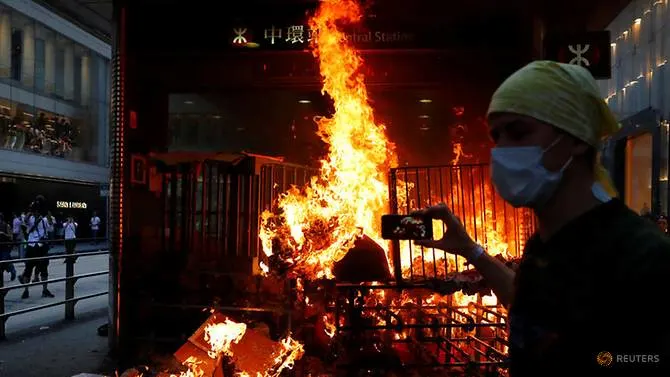Hong Kong police fire tear gas after clashes erupt as protesters start street fires
10 September, 2019

Protesters set barricades, smashed windows, started street fires and vandalised the MTR metro station in Central district in Hong Kong on Sunday (Sep 8).
Central district, home to banks, jewellery shops and top-brand shopping arcades, was awash in graffiti, broken glass and bricks torn up from pathways. Protesters set fires from cardboard boxes, building barricades with metal fencing.
Police moved on protesters from the Central business district who dispersed to nearby Admiralty, the bar district of Wan Chai and on to Causeway Bay in a now familiar pattern of cat-and-mouse clashes over three months of unrest.
Thousands of protesters earlier called on US President Donald Trump to "liberate" the city as they marched to the US consulate. They waved the Stars and Stripes and placards demanding democracy.
"Fight for freedom, stand with Hong Kong," they shouted before handing over petitions at the consulate. "Resist Beijing, liberate Hong Kong."
Dense crowds of protesters spent hours slowly filing past Washington's consulate in the thick tropical heat.
In chants and speeches they called on the US to pressure Beijing to meet their demands and for Congress to pass a recently proposed bill that expresses support for the protest.
But as evening set in, riot police chased groups of hardcore protesters who blocked roads, vandalised nearby subway stations and set makeshift barricades on fire.
They cleared the Central MTR subway station, near Sunday's march, where activists smashed a long glass panel at a station entrance and other windows and daubed graffiti on the walls outside. Several arrests were made.
Activists dug up bricks from pathways to break windows and set fires from cardboard boxes on the streets, building barricades with metal fencing.
One fire burned at an entrance to the subway in the corporate district of Central, where a protester also smashed the station's exterior glass.
In the shopping area of Causeway Bay, officers fired tear gas outside another subway station.
Paramedics took away on a stretcher a man who collapsed after inhaling the gas, and police detained suspected protesters inside that station.
Pockets of protests also broke out in Kowloon over the harbour from the main island of Hong Kong on Sunday night, including in Prince Edward, close to the densely populated district of Mong Kok.
Police prevented protesters from blocking access to the airport but fired tear gas for a second night running in Mong Kok.
As activists jammed Hong Kong streets in a bid to ramp up international pressure on Beijing, hardcore protesters later clashed with riot police across the city's core.
Millions have demonstrated over the last 14 weeks in the biggest challenge to China's rule since the city's handover from Britain in 1997.
The protests were lit by a now-scrapped plan to allow extraditions to the authoritarian mainland, seen by opponents as the latest move by China to chip away at the international finance hub's unique freedoms.
But after Beijing and city leaders took a hard line the movement snowballed into a broader campaign calling for greater democracy, police accountability and an amnesty for those arrested.
Sunday's protest featured another massive turnout for a movement that has gripped the semi-autonomous territory and plunged it into a political crisis.
BEIJING RILED BY CRITICISM
Hong Kong is a major international business hub thanks to freedoms unheard of on the mainland under a 50-year deal signed between China and Britain.
But Beijing balks at any criticism from foreign governments over its handling of the city, which it insists is a purely internal issue.
Authorities and state media have portrayed the protests as a separatist movement backed by foreign "black hands", primarily aiming their ire at the US and Britain.
While some American politicians on both sides of the aisle have expressed support for the democratic goals of the protesters, the Trump administration has maintained a more hands-off approach while it fights a trade war with China.
Trump has called for a peaceful resolution to the political crisis and urged China against escalating with a violent crackdown.
But he has also said it is up to Beijing to handle the protests.
Washington has rejected China's allegations that it is backing the demonstrators and Beijing has shown little evidence to back its claims beyond supportive statements from some politicians.
The protests show no signs of abating, and the city's unelected pro-Beijing leader Carrie Lam has struck an uncompromising tone for much of the last three months.
On Wednesday, she made a surprise concession, announcing the full withdrawal of the proposed extradition bill which sparked the demonstrations.
Protesters across the spectrum dismissed the gesture as too little, too late, saying their movement would only end once the remainder of their core demands were met.
"Our government continuously takes away our freedoms and that's why people are coming out," a 30-year-old protester in a wheelchair who gave his surname as Ho told AFP on Sunday.
Analysts say it is difficult to predict what Beijing's next move might be.
Source:
TAG(s):
